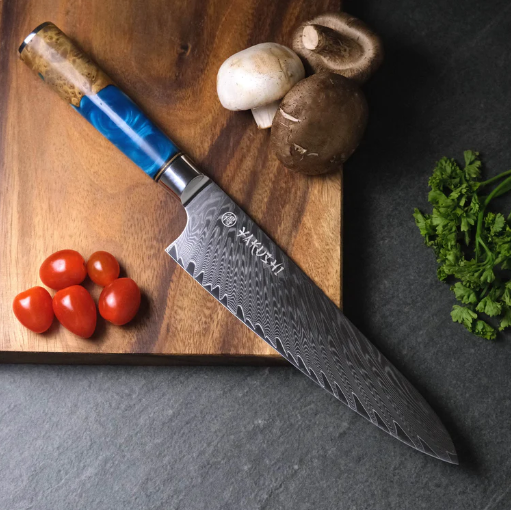When it comes to culinary artistry, every chef knows that their tools can make or break their masterpiece. One essential tool in any kitchen is the knife, and not just any knife will do. The right knife can turn a chore into a joy and transform an ordinary meal into a culinary delight. Among the myriad choices available, Damascus kitchen knives stand out for their beauty, performance, and history. In this guide, we’ll explore what makes a Damascus kitchen knife unique and provide valuable insights into choosing the right one for your culinary needs.
What Sets Damascus Kitchen Knives Apart?
Damascus steel, a term often used interchangeably with “Damascus kitchen knives,” refers to a type of steel characterized by its distinctive wavy or mottled pattern. But what makes Damascus knives so special? It’s a combination of factors:
Unmatched Aesthetic Appeal:
Damascus steel is renowned for its striking visual appeal. The unique patterning, formed by layers of steel folded and welded together, creates a mesmerizing water-like pattern on the blade. This not only adds an artistic touch to your kitchen but also reflects the knife’s craftsmanship.
Exceptional Strength and Durability:
Damascus steel isn’t just about looks; it’s incredibly tough. The layering process enhances the knife’s strength, making it resistant to chipping, breaking, and other damage. This resilience ensures your knife will withstand the rigors of everyday use.
Superior Sharpness and Edge Retention:
One of the most critical aspects of a kitchen knife is its sharpness. Damascus knives are famous for their razor-sharp edges, which make slicing, dicing, and chopping a breeze. Additionally, they hold their edge for a long time, reducing the need for frequent sharpening.
Versatility:
Whether you’re a professional chef or a home cook, versatility in the kitchen is essential. Damascus knives come in various shapes and sizes, making them suitable for a wide range of tasks, from precision slicing to heavy-duty chopping.
Choosing the Right Damascus Kitchen Knife
Purpose and Usage:
The first step in selecting a Damascus kitchen knife is determining its intended purpose. Do you need a versatile chef’s knife, a nimble paring knife, or a sturdy cleaver? Your choice should align with the tasks you perform most frequently in the kitchen.
Blade Style:
Damascus knives come in various blade styles, each suited to specific tasks. Here are some common options:
Chef’s Knife:
A versatile, all-purpose knife ideal for chopping, slicing, and dicing.
Santoku Knife: A Japanese knife with a shorter, wider blade, perfect for precision cutting.
Paring Knife: A small, agile knife designed for peeling and intricate work.
Bread Knife: Featuring a serrated edge, it’s perfect for slicing bread without crushing it.
Utility Knife: A mid-sized knife for various everyday kitchen tasks.
Choose a blade style that complements your cooking style and preferences.
Blade Length:
The blade’s length plays a crucial role in its functionality. Longer blades are excellent for slicing and chopping, while shorter blades offer more precision and control. Consider the size of your hands and the space in your kitchen when deciding on the blade length.
Handle Design:
The handle is often an overlooked but crucial aspect of knife selection. The handle’s comfort and grip can significantly affect your cooking experience. Look for a handle that feels ergonomic in your hand, offers a secure grip, and suits your personal preferences regarding material and design.
Maintenance and Care:
To keep your Damascus knife or handmade butcher knife in top condition, it’s essential to consider maintenance. Damascus knives are often not dishwasher safe and require careful hand-washing and drying to prevent rust or damage to the blade. Make sure you’re willing to invest time in proper care to preserve your knife’s beauty and performance.
Closing Words
Choosing the right Damascus knife is a journey that combines functionality, aesthetics, and craftsmanship. These knives are not just tools; they are a testament to centuries-old metallurgical artistry that enhances your culinary experience.

